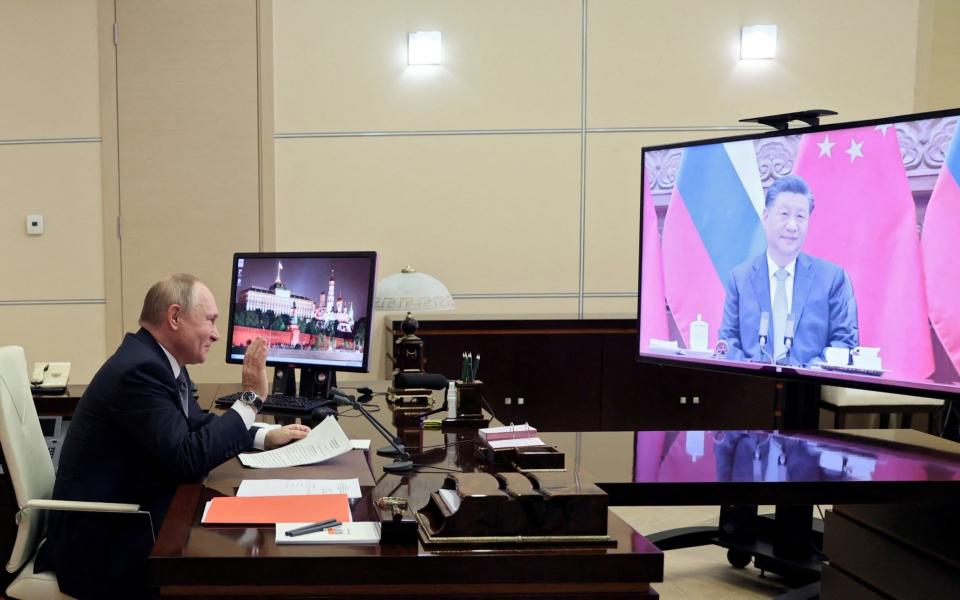Russia looks east as China link threatens to inflame Europe’s gas crisis

When Vladimir Putin attends Beijing’s winter Olympics in February, he is sure to have one eye on a major new energy deal that would deepen Russian ties with the eastern superpower.
Putin and his Chinese counterpart, Xi Jinping, are believed to be finalising a deal for Russia to more than double pipeline gas exports to China. It would mean up to fifty billion cubic metres (bcm) more natural gas transported every year via a major new planned pipeline – Power of Siberia 2.
Despite Europe being gripped in recent months by tensions around Russia’s new pipeline to Germany, Nord Stream 2, and soaring gas prices, Putin’s plans for almost equivalent capacity going in the opposite direction have gone less noticed.
Experts warn of the impact on European energy security and prices, and of Moscow’s growing grip on global markets at a turbulent time for energy supplies in the push to slash carbon emissions.
“If the project is signed and the pipeline is completed, Russia will be able to sell gas from the same fields that serve [the West], and that diversification provides additional leverage,” warns Alexander Gabuev, chair of the Russia in the Asia-Pacific Program at the Carnegie Moscow Centre think-tank. “It’s a pretty significant volume.”
The potential deal for the new pipeline is approaching amid a global shortage of gas supplies which has pushed prices to record levels and caused steep hikes in household and businesses energy bills across the UK and Europe.
About 40pc of Europe’s gas comes from Russia with some exported to the UK. While Britain gets little gas directly from Russia, its prices closely track those on the continent.
China and Russia’s energy ties have been deepening in recent years. The first direct natural gas pipeline between the two – Power of Siberia – opened in 2019, and spans the 2,200km between northern China and Russia’s Kovykta and Chayanda gas fields in eastern Siberia.
Flows are ramping up towards its capacity of 38bcm per year, predicted to be reached in 2024, while more than expected has been pumped in recent months to ease energy shortages in China that threaten its productivity.
As China tries to lessen its reliance on coal, the country’s demand for natural gas is rising. Meanwhile, Russia is making sure it diversifies from Europe where the future of natural gas is uncertain as the Continent seeks to cut a reliance on fossil fuels. It currently sells about 180bcm per year to Europe.
And while the eastern Siberian fields attached to the current route only supply China, the potential new gas pipeline linking China and Russia will use gas from the Yamal area of western Siberia which also supplies Europe. It raises questions for the future supply to the Continent.
It is thought there is enough gas in the Yamal area to supply both markets, but Russia could use the diversity of the customer base to its advantage.
“The question is, would it [increase production to serve both centres] or would it optimise between the two – sell into the market which is going to pay the higher price,” asks Tomas Marzec-Manser, head of gas analytics at ICIS.
China can afford to buy greater amounts. It has been purchasing pipeline gas through long-term contracts linked to oil prices – a common feature of the international gas industry. Thus the amount recently paid is less than Europe, which relies more on short-term contracts and the spot market where prices are soaring.
In October, China was paying $4-$7 per Mmbtu (£3-£5), even as prices in Europe climbed above $20 per Mmbtu, data from ICIS shows.
“It’s a gradual change of customer base, which is something that Europeans ought to keep in mind,” says Filip Medunic, at the European Council on Foreign Relations think-tank.
If it gets to the point where Russia can afford not to supply Europe and wants to use gas supply as a political tool, he notes, “that’s really dangerous, because that’s super difficult to resolve.”
Medunic urges Europe to make sure it has the right contracts in place so “we don’t end up again in a situation in winter where there isn’t enough and we have to ask for more.”
Gabuev also warns of the potential risks for Moscow becoming too reliant on Beijing. Australia has recently seen an unofficial block on some imports into China in what was perceived as political retaliation.
While Power of Siberia 2 has been discussed for years, it has gained fresh impetus amid tensions with the West. Critics accuse Russia of compounding Europe’s energy crisis, arguing Putin is withholding extra gas supplies to pressure German regulators into starting up the Nord Stream 2 pipeline under the Baltic Sea.
According to reports, Putin and Xi discussed the pipeline on a call on December 15 while the Russian president later hosted Ukhnaagiin Khürelsükh, the president of Mongolia, where the pipeline will travel through.
Meanwhile, Gazprom, Russia’s state gas giant, is conducting a feasibility study for the pipeline which would be built alongside the China National Petroleum Corporation. Platts Analytics’ base case expects it to go ahead, with flows to begin as soon as 2027.
With the gas supply deal behind the existing pipeline having been signed shortly after Russia’s Winter Olympics in 2014, this year’s contest in Beijing may once again prove the catalyst for a deal.
“We don’t know whether the contract will be ready by then,” says Gabuev.
“But I think that there’s a lot of political and commercial incentive to sign it sooner rather than later in the first face-to-face encounter in nearly three years.”




